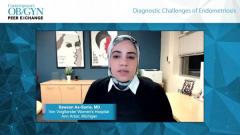
Discussing Endometriosis Options With Patients
A panel of experts provide an overview of choosing endometriosis treatment and how to discuss these options with patients.
Episodes in this series

Hugh Taylor, MD: Susie, how do you choose when you’re talking with your patients about GNRH antagonists? What discussion do you have with your patients?
Sawsan As-Sanie, MD: That’s a good question. It goes back to what you mentioned: does the patient feel more comfortable with a lower degree of suppression, with a longer duration of use without add-back therapy? In that situation, elagolix at the lower dose might be appropriate. Patients who want more aggressive treatment might be more likely to choose the higher dose of elagolix vs the relugolix with add-back therapy. One obvious difference between the 2 is that if you have a contraindication to using any form of estrogen, that relugolix combination therapy is not an approved option. For patients with a prior venous thrombotic event, for example, that would be contraindicated for that small group of patients. Those would be some of the considerations. The benefit of using either of those 2 options that are approved for up to 2 years is important. Part of all our counseling is that endometriosis is a chronic condition. There’s no end. Even in patients who undergo surgical therapy, long-term suppression is part of the discussion that I have with the vast majority of patients. Trying to find a solution that can offer very long-term suppression is central to counseling.
Hugh Taylor, MD: Jessica, the low dose of elagolix and relugolix are once-a-day dosing, whereas the high dose of elagolix is twice-a-day dosing. Is that part of the decision-making with your patients, especially with adolescent patients who may have more trouble with the twice-a-day dosing?
Jessica Shim, MD: Definitely. We’re talking about patients who might be off to college, and they’re going to be responsible for their medicine. It can be quite challenging to do once- or twice-a-day dosing.
Hugh Taylor, MD: Rob, how often do you follow up with patients once you decide on a treatment regimen, whether it’s an oral contraceptive, a GNRH antagonist, or any of the things we’ve talked about? How often do you see them? How do you describe treatment goals with your patients?
Robert Taylor, MD, PhD: Those are great questions. Obviously, you’ve got to give the therapy you’re initiating an opportunity to work, for patients to achieve therapeutic levels. Typically, you want probably a couple of months of therapy before you reevaluate. Following that, you probably want a 6-month visit if things are going in the right direction. That would be an appropriate next step. Maybe another 6 months and annually after that. It’s important to keep in contact with phone calls and have your nurse follow-up with individuals to make sure they’re progressing well and getting better. We have a lot of options, and it’s appropriate to change those if you’re not making good progress.
Hugh Taylor, MD: I do the same: 6 to 8 weeks. I have initial follow-up, and if we’re making another change in medication, a change in dose, changing to a different regimen, it’s…
Robert Taylor, MD, PhD: Another month or so.
Hugh Taylor, MD: …another 6 to 8 weeks of follow-up. Once they’re pain-free and without significant adverse effects, we’ll move to a 6-month follow-up visit. Does anybody else have another treatment regimen or a follow-up regimen that they follow?
Linda Giudice, MD, PhD: Mine is pretty similar. At some point, if things aren’t working, then I turn to surgical referral. It’s important to talk about that.
Hugh Taylor, MD: That’s very important. When do you consider surgery?
Linda Giudice, MD, PhD: It’s always a discussion with the patient. If there’s no improvement in pain—say, on progestins, even with a trial of the GNRH antagonist—then a consultation with a minimally invasive gynecologic surgeon is made. We use a lot of imaging—transvaginal ultrasound to look for endometriomas and other things that can cause pain. We use MRI frequently in terms of looking for deep-infiltrating disease. A lack of response with DIE [deeply infiltrated endometriosis], for example, is usually a quick referral to a gynecologic surgeon.
Hugh Taylor, MD: Susie, you are that gynecologic surgeon.
TRANSCRIPT EDITED FOR CLARITY
Newsletter
Get the latest clinical updates, case studies, and expert commentary in obstetric and gynecologic care. Sign up now to stay informed.


























